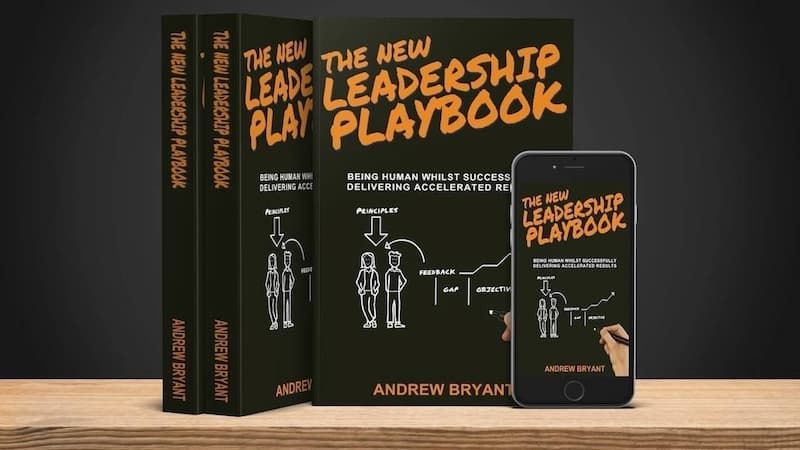Self Leadership and
The New Leadership Playbook
Blog by Andrew Bryant
A Model for Transforming the Executive Leadership Team

The Executive Leadership Team (ELT), typically consisting of the CEO, CFO, COO, CPO, CMO, CRO, CTO, and other CXOs, should be the most important team in the company. Why is it then that the ELT is often:
"The worst performing team in the whole company!"
The answer is that most Executive Leadership Teams are not structured as a team but rather as a workgroup. A team's success is dependent on the collaboration of each member of the team towards a shared goal. In short,
"Nobody wins unless everybody wins!"
In a workgroup, each member focuses on their silo of responsibility and measures success in terms of their own KPIs or OKRs. In a workgroup, each member reports to the CEO but is competing for attention and resources. This structure results in little or no collaboration and can promote a culture of internal competition and distrust.
A High-Performing Executive Leadership Team
“I think I have a job for you", he said.
"I have taken on a new CEO role, and I need my disconnecte...
What can Leaders do to face the Challenges of 2023 and beyond?

Leadership cannot be summarized in a simple meme, that says leaders do this, and don't do that. Leaders face multiple complex challenges in today's rapidly changing environment. In addition to external challenges, they must navigate the complexities of bringing their own people together to work collaboratively while managing their own physical, social, and mental health.
In this post, I aim to summarize some of the challenges leaders face in 2023 and beyond and offer some insights about what is required and what can be done.
What Keeps C-level Leaders Up at Night?
McKinsey's State of Organizations 2023 report identifies many of the challenges keeping leaders up at night, These include economic volatility, geopolitical instability, and the lingering effects of the COVID-19 pandemic.
C-level leaders must address questions about how to organize for speed, the balance between in-person and remote work models, and mental health concerns among employees.
Deloitte's Human Capital Trends ...
Why Love is the Secret for Feedback and Growth

I imagine you like to laugh, but how do you feel about being laughed at?
We will all be laughed at by others for something, at some time, whether that is for our actions, our words, or our beliefs. Rather than 'going postal', we usually laugh it off and get on with our day, but it is my experience that even the calmest people have a sensitive spot that doesn't respond well to ridicule.
Can You Take a Joke?

I am English by Birth and married to a Brazilian. Just this sentence often evokes laughter, because the cultural differences are so obvious. When we first met, my wife expressed a Brazilian idea:
"It's better to lose the friend than lose the joke".
This means that nothing is out of bounds and in today's PC Culture where people are easily offended, this is a radical concept.
I bravely accepted the challenge but was unprepared for the realization of the number of 'sensitive spots' that I was carrying, and the challenge to my self-image when these were pointed out. This post...
Unleashing the Power of Critical Thinking to Model and Repeat Success

John joined the coaching call eager to share his success. He recounted how he had applied his learning from our previous sessions and utilized critical thinking to analyze how to influence key stakeholders to buy into a solution.
I celebrated John's success and helped him unpack each step he took in developing the influence capital to achieve his objective. This prompted John to ask the question,
"How do I repeat this?"
Making Critical Thinking a Habit
The Greek Philosopher Aristotle taught that we are what we repeatedly do. Excellence, he espoused, is not an act but a habit. In this post, we will explore the importance of critical thinking for success and how to strive for excellence by making it a habit.
Critical thinking is a cognitive process that involves careful analysis, evaluation, and synthesis of information to make reasoned judgments and decisions. Critical thinking is a Power Skill that is essential for the future of work. By leveraging critical thinking, we can mo...
5 Crucial Do's and Don't of Leadership You Should Know

Leadership is a complex and multi-faceted topic. To be an effective leader requires awareness of the context in which you are leading, the motivation and skills of the people you are leading, and your own leadership style. Despite the complexity, there are some do's and don'ts that can help you become a more efficient and effective leader. In this guide, we'll cover five of the most important leadership do's and don'ts.
Leadership Do's
1. Communicate Openly and Frequently
One of the most important things a leader can do is keep lines of communication open. This means being accessible to your team and encouraging two-way communication. Leaders should make it safe to ask questions and be available to address concerns (psychological safety). Being responsive to feedback builds trust and engagement.
2. Be Decisive
Leaders must be able to make decisions quickly and confidently. Indecision breeds confusion and causes morale to suffer. Sharing why and how a decision was made creates buy-...
How to Read the Room on Zoom
How do you read the room on Zoom?
I was asked this question by one of my coaching clients who wanted to transform her influence, to get the promotion she sought.
I’d previously shared with her that in addition to projecting gravitas and confidence, executive presence means, reading the room.
The Greek Philosopher, Aristotle wrote, that in order to influence, we need pathos. Pathos gives us the English word, empathy, meaning the ability to understand the feelings and motivations of your audience. This is what I mean by reading the room.
Pitching your idea, or presenting information without knowing what state the audience is in or what’s important to them, is like driving on a freeway blindfolded.
So, how do you read the room, and how do you do that in a Zoom, or Teams environment when many participants have their cameras off?
Well, if you are still listening to me, then I already know something about you.
You are curious and open to learning. You are ambitious and want to improve your influenc...
Personal Branding - How to build your Brand

Jeff Bezos famously said, "Personal Brand is what people say about you when you leave the room", but executive presence is what will get you into the room in the first place.
If you are not known for something, or unforgettable, you can forget career advancement or financial success.
Boss-Level Personal Branding

The key to personal branding is that you clearly communicate your value, and that value is relevant to your audience (clients, colleagues, senior executives).
I was recently coaching a Professional Speaker in Singapore, who was struggling to find his 'tagline', that value statement that follows your name.
Do you have a tagline?
Ironically, this speaker was an expert on communication, but calling himself, 'The Communication Expert' was a bit too generic, so I challenged him to articulate, his Message, his Methodology, and his Market. I asked him what problem he solved for people and what they said about him after he solved it for them.
Do you know what problem you ...
10 Questions for Creating Change

When creating change, whether personally or within an organization, you will encounter resistance. People will tell you they are on board with the new vision but then engage in behaviors that sabotage objectives.
The first key to creating change is to acknowledge that every behavior has a ‘frame of mind’, constructed of values, beliefs, identity, and intentions. This frame of mind can be conscious or unconscious but will act like a gyroscope, always bringing your behaviors back towards a programmed destination.
Let’s take an example of creating change that most of us are familiar with – dieting to lose weight. We have a vision of ourselves as fitter or thinner, and we set a goal to lose X number of kilos by Y date; but what do we do? We cheat, we make exceptions and before long we are eating as we have always done.
Why do we default? Because our eating behavior, like all our behaviors, is controlled by a frame of mind. What are some common frames for eating? Food is comfort, food is...
Choosing the right Executive Coach for you

Choosing an Executive Coach for yourself can be a little confusing, to say the least. Your Executive Coach is going to be your confidant and you will need to open up to get the best from the relationship. So whether you are spending your own money or your organization is providing you with a coach, it’s helpful to have more than just a ‘gut feel’ to go on.
Coaching Chemistry Call
Most coaches will give you a no-obligation, 30 to 60-minute ‘chemistry’ meeting to assess if there is a fit for both parties. That’s right, an experienced coach may spot you are not committed to the process, or the organization has misaligned expectations and so excuse themselves from the assignment.
I recommend that you meet with at least two coaches but no more than four. Meetings can be face-to-face, by video conference, or by phone. Try and ask each coach the same questions, and take note of the questions they ask you. A good coach is going to get you to step back and think. You will find yourself sayin...
The Secret to Effectively Managing Employee Mistakes

I will always remember an inspiring speech by Darrell, a CEO that I was coaching. The occasion was a ‘town hall’ for employees just after it was announced that he would be moving on to new pastures.
“Make mistakes”, he said.
“Just don’t let your mistakes be bigger than mine”
It is not often we hear a leader encourage his team to make mistakes, but Darrell knew that making mistakes was part of the business and that you should limit the size of your mistakes. Darrell’s leadership had created a culture of creativity and customer service, and many people openly wept on his last day.
A critical test for any leader is how they effectively manage employee mistakes. Mistakes are inevitable but your response to them will determine whether you enhance productivity and employee engagement or destroy moral.
A simple maxim for mistakes would be –
“Be tough on standards, be tender on people.”
Before I discuss how to implement this mindset, it is worth noting that we each have a default orient...


